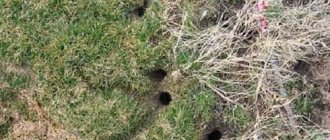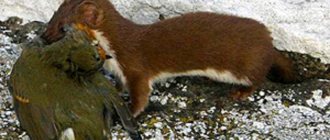The mole is a carnivore. Its main food is earthworms, which are so necessary and useful for the fertility of garden beds. True, in addition to this, the mole will be able to free the garden from mole crickets, fly larvae, May beetles and click beetles, from slugs and cutworm caterpillars, mice and even rats. The small mammal is not at all interested in root vegetables or tomato bushes. However, when hunting for its prey, it digs so many underground tunnels that whole pieces of beds with onions or carrots can fall into them. Heaps of earth dug up by the animal regularly appear in the most unexpected place for a gardener. And a recently planted young tree, whose roots are undermined, begins to dry out, leading the gardener to despair. So, how to get rid of moles on your property: the most effective way.
Reasons for appearing on the site
Moles eat a lot and often; if they stop doing this, they can die within 24 hours. They most often live alone, but can also live in family groups, so several hundred meters of underground roads can be laid under a garden plot or vegetable garden in just a few days. Molehills are located not only parallel to the plane of the earth. The mole's lair, in which the female gives birth to her cubs, is usually located at a depth of 1.5 m to 2 m.
Moles will not be able to live where they cannot provide themselves with food and water. In garden plots where organic farming is practiced, there is always an abundance of earthworms - the main food of moles. After all, cultivated garden and garden plants are regularly fertilized and watered, that is, people provide the necessary conditions for soil fertility and nesting of worms. Behind the worms, moles appear on the site. Nearby streams or other sources of water are the second reason for populating a fertile vegetable garden.
Calling professionals
You can always turn to representatives of specialized services for help in exterminating moles; this option will require financial expenses, but will be highly effective and guaranteed for the period specified in the concluded contract.
Typically, specialists use the following methods for exterminating pests:
- Carbonation, which consists of chemical treatment of underground passages. Depending on the type of insecticide, you can destroy pests, drive them directly into placed traps, or simply scare them away from your summer cottage.
- Fumigation, which is used to treat large areas with a toxic cloud, is one of the most effective methods that is guaranteed to destroy moles.
- Installation of high-quality traps on the site.
Prices from different companies may vary, below is the approximate cost of such services:
- Destruction of moles, if the site is located less than 40 km from the city, will cost 6,000-8,000 rubles.
- If the site is located further, the price increases to 8,000-10,000 rubles.
- Maintenance of the site throughout the season costs about 18,000-20,000 rubles.
What harm is done to the garden?
When moving into a new area, a mole sets up its main home under the roots of trees. From here the beast builds two main tunnels. Feeding roads break out from the central roads in all directions, ending in holes leading to the surface. Exits to the surface also work as devices for ventilation of underground pipelines.
Most passages are located at a depth of 20-30 cm, that is, in the layer of earth where the roots of vegetables, flowers, and shrubs penetrate. By undermining the soil, the animal leaves the plant without food. Throwing soil to the surface while digging exits, making shallow roads that leave twisting, bulging ridges, moles turn land into a kind of dug up landfills. Lawns and flower beds look especially unsightly when there are dried or fresh piles of earth next to dead flowers.
Scare away with smells
It is more difficult to repel moles with odors than insects. If an odorous substance gets into the tunnel, the burrowing animal will make a new move, but will not leave the area. Scented repellents can only work at the stage of development of the site if they are buried along its perimeter or along the fence separating the dacha from the neighboring meadow. Moles come to the garden from the wild because they find more food in the treated and moistened soil.
At a depth of 50-80 cm, you can bury rags soaked in gasoline, waste oil, kerosene, diesel fuel and other petroleum products, which will create a barrier for soil pests seeking to enter the garden. This way you can scare away not only the mole, but also the mole cricket. The smells will last for several years.
Prevention on site
It often happens that somewhere not far from the site there are mounds dug up by moles. There are no such earthen piles on the site itself, but work is planned to improve the fertility of the land - a compost heap or manure pit is being prepared, mulching with a thick layer of freshly cut grass is being planned. In this case, you can be sure that blind diggers will come to hunt for worms, which will certainly appear under heaps of organic fertilizer.
There is only one way to protect yourself from their invasion, where there are no underground passages yet: to fence the perimeter of the site with a protective barrier that will either scare away or prevent them from digging a tunnel.
The most reliable barrier is considered to be one made of fine-mesh thick plastic or metal mesh, sheets of slate, roofing felt, or linoleum. All materials must be durable, able to withstand the powerful claws of the mole's front paws. You will have to dig the selected material to a depth of at least 50 cm. In this case, the upper edge of the fence should protrude 40 cm above the ground. Although it is believed that moles do not walk on the ground, it is known for sure that these animals can come to the surface and move over short distances.
What are moles afraid of?
When searching for food, these insectivores rely on information they receive through their sense of smell and hearing. They do not like strong odors, such as the stench of rotten fish, the smell of valerian, the stench of various chemicals such as white alcohol or carbide. Loud noise and vibration of the soil are also sources of anxiety for moles.
What plants can scare away
Plants whose roots emit a sharp, spicy odor—garlic, onions, daffodils, marigolds, castor beans—can scare off moles. Animals do not climb into a flower bed where hazel grouse grow along the edges, many sources on the Internet write about this. But it should be borne in mind that this barrier will be temporary, as long as plants with an odor difficult for moles are in the ground. At the same time, some individuals know how to deal with unpleasantly smelling plants: they simply push them out of the ground or go around a little deeper than the roots of the plant go down.
Preventive measures
It is better to prevent an underground inhabitant from settling in the countryside than to fight and save the plantings. Let's start with preventative methods.
Horizontal grids
A special mesh is placed under the lawn at a depth of 10 cm (so as not to damage the aerator holes of the mesh with garden tools). Cover the top of the mesh with soil and sow grass. The mesh creates an insurmountable barrier for the rodent.
This mesh can be used throughout the garden (lawn) for protection.
There is only one problem: this method is only suitable for a newly laid garden or lawn, where it is possible to form the surface and remove the soil. It's hard to imagine using it in an existing garden.
Vertical grid
You can also place a grid around the perimeter of the site like a deep (up to 60 cm) foundation.
Such a barrier around the perimeter of the site will make it highly likely that shrews will not get into the garden.
Stone strip
A stone ribbon around the site can give a similar effect as a deep foundation. The ditch is located along the fence at a depth of more than 60 centimeters, about 30-40 cm wide, and is filled with stone debris and broken stones. Theoretically, this will be an insurmountable obstacle for the pest.
How to get rid of it using folk remedies
Moles can leave those parts of the garden where the owners have placed foul-smelling protein food - rotten eggs, fish, chopped onions - into their new, recently appeared holes.
Essential oils of pine and lavender, castor oil, and gum turpentine will help scare them away. Pieces of natural fabric or cotton wool are impregnated with these substances. They lay the material in the passages, above which there is freshly dug earth. The holes must be filled and compacted.
In addition, odorous substances are mixed into dough balls made from flour and water. The balls are dropped throughout the area with a distance of 0.5 m - 1.0 m from each other. Strong-smelling technical materials such as gasoline, tar, kerosene are simply poured into the holes and the holes are sealed.
If there is a mouse-cat in the house, he can easily retrain if he is shown how a mole moves in an underground passage at the moment the soil is thrown to the surface.
Using used cat litter to fight moles from Evgeniy Klyuev
In war, all means are good. Evgeniy Klyuev, for example, uses used cat litter (a good owner, as you know, never wastes anything, even used cat litter).
In a bucket of water, mix a lump of litter with cat waste. Fill the mole holes with the resulting solution, and then cover them with earth. Take a piece of reinforcement and use it to make many holes in the ground near the molehills. The animals will then move to a safe distance and stay away from your area.
How to make a repeller with your own hands
Bloggers sharing their experience of fighting moles on the Internet believe that the most effective way to scare away pests from a site is to act on them accompanied by a loud, sharp sound.
Tin repeller
A simple device made with your own hands from a tin can, placed on an iron rod dug into the ground, will emit sounds with every breath of wind that can easily penetrate deep into the loose soil. This method may not be effective on dense clay soils. Tin cans can be from various drinks - this does not matter. The main thing is that their size and volume are sufficient so that the sounds are sharp and loud.
Tin cans can be easily cut using a sharp knife on the pinwheel blade and can also be adjusted to the rods. You can attach not one, but several turntables to one rod, this will enhance their sound and rotational force. At the bottom of such a device you can attach a bell. Every time the wind blows, the propeller will spin and make the bell ring. If such devices are placed sufficiently densely around the site, then there is hope of getting rid of the moles already living on the site, and new “guests” will definitely not enter the site.
Alarm
A mole repeller is quite simply made from the simplest and cheapest battery-powered electronic alarm clocks. Several alarm clocks set different times for the daily ringing. A wire is connected to the clock device, with the help of which the alarm clock is lowered into a long pipe. Holes must be made in the bottom of the pipe. The alarm clock is attached to the pipe with wire. The pipe is dug into the ground in a vertical position. The top hole of the pipe is protected with a plastic bottle.
The alarm clock can be placed in a glass container, which must be tightly closed with a lid. The jars are dug to a depth of 0.5 m. The sounds of alarm clocks scare away moles, and they quickly leave areas with ringing objects.
Using sound
Soil inhabitants (moles, mole crickets, mice, worms, etc.) are sensitive to the effects of impacts on the surface, which are transmitted deeper. To effectively scare away moles, summer residents often use simple ratchet structures. You will need:
- cuttings of metal water pipes longer than 80 cm;
- reinforcing rod or welding steel wire 0.7-1 cm thick;
- wooden plugs for the pipe, equal to its internal diameter;
- plastic mineral water bottles (hard and transparent) or 0.5 liter aluminum beer containers.
When installing such repellers, you need to know that the main mole tunnels run at a depth of at least 70 cm, and you will have to drive the pipe into the ground at approximately the same distance. It is better not to dig in the pipes, but to hammer them in with a sledgehammer, so as not to disturb the density of the soil and its ability to transmit sound.
The ratchet is made from a lightweight plastic or aluminum can:
- In the bottom of a PET bottle or the top of an aluminum container, a hole is made slightly larger than a rod. When rotating, the container should swing slightly, tapping the rod. The easiest way to burn a hole in a plastic bottle is with a soldering iron.
- Cut several “doors” on the sides and bend each flap outward. The doors should bend in one direction.
- Try the prepared ratchet on the rod. When using aluminum cans, you will have to push the central part of the bottom a little so that the can body can rotate. For a PET bottle, the pin fits comfortably into the neck (do not remove the cap).
- Insert a wooden plug into the hole of the driven pipe. Drive the pin into the wood and put a pinwheel from a bottle on top.
The design works even in low winds. The noise, which is almost inaudible to humans, is amplified by the pipe and transmitted into the soil, scaring off not only the mole, but also other soil inhabitants.
Which product to choose
Many land owners, having encountered the problem of damage to garden plants by moles and having tried various methods of repelling, protecting and controlling pests, know that moles are not a death sentence. Now there are many methods that can be used to achieve a significant reduction in the animal population or their complete departure from the site.
Some gardeners are of the opinion that the best option is to control the number of individuals in a given area rather than completely expel or destroy them. But most owners of garden plots and vegetable gardens strive to achieve the complete absence of hated animals on their land and therefore purposefully use means leading to their destruction.
Poison
Poisonous products are sold in the form of gels, granules and grains, which must be dropped over the area or placed in mole passages. But very often these animals simply throw such substances to the surface, much less eat them. Some gardeners prepare poisonous food themselves. For this purpose, worms are caught. They are cut into pieces and sprinkled with powdered poison. The worms do not lose mobility for some time. The faster they are spread out along the moles’ passages, the faster the animal will react and come to profit from the poisoned prey.
Trap
Mole traps made of thick wire have proven to be the most effective devices for catching moles. These traps have been used for a very long time. Already in the last century, gardeners saved their harvests with the help of this simple technique. They consist of a long spring, a loop, a guard and a pressing tab. Mole traps are installed in the direction of movement of the animal in the hole connecting the molehills. For maximum effect, use two traps in one place.
Properly installed mole traps allow you to catch an animal the first time. If this does not happen, the devices are used elsewhere on the site. Mole traps are durable and inexpensive, making them very popular among those trying to completely get rid of moles. To destroy them, crusher-type rat traps are also used, which are installed under opaque material in an underground passage.
Trap
Those who simply want to remove a mole from an area without causing significant harm to the animal are recommended to use a trap made from a 3-liter glass jar. It is dug between two holes in the ground along which the diggers move. The jar is positioned so that the entrance to it is below the mole holes. Live worms are placed inside the jar.
The mole, moving on its own, should simply fall into the jar. He won't be able to get out of it on his own. In order to create the appearance of an undisturbed passage, the hole is covered with dense material - pieces of slate, roofing felt, wood, covered with black plastic.
Destruction of moles
Trap in a wormhole
Before moving on to inhumane methods of influencing animals, you should think several times. Killing an animal as useful to wildlife as a mole, to put it mildly, is not recommended. Yes, it is a pest for the gardener, but life on Earth is not limited to agricultural land.
Well, if the gardener decides to go with the “cleaning up” option, there are several ways to solve it:
1 Filling mole holes with water. This is the most popular way of fighting. It is especially effective at the very beginning of mole activity on the site. If the moment is missed, its effectiveness is significantly lower, since the mole will have many more places where it can wait out the “flood”.
Mole repellent
2 Treatment of mole holes with toxic chemicals (gassing). It can be done either handicraft or with the assistance of professionals.
When performing this procedure, you must take all precautions so as not to harm yourself or others!
Poison against moles
3 Use of poisoned baits. Despite the abundance of means (such as Antikrot, Carbidex, Detia, etc.), it cannot be said that their effect is not very significant. Perhaps the fact is that the mole is a predator and this kind of bait is ineffective for it
Detia for repelling moles
4 Live fishing. One of the most difficult methods involves chasing a mole as it rummages literally online, blocking all escape routes. A very labor-intensive method that involves digging out all the freshly dug mole holes.
5 Setting traps. There are a huge number of traps aimed exclusively at moles, installed in wormholes or wormholes. They are very effective, but in order for the venture to be successful, you must purchase a sufficiently large number of such products. This is due to the fact that the system of mole passages can be very branched.
Reviews
Fighting moles just so that you can leave them alive is only permissible if it is possible to send them far into the forest. Let it feed on insects that are found in the ground under the pine needles. And in the garden there is only a merciless struggle.
Maxim, 33 years old, Serpukhov
We need to trust cats more. We now have two young mousecatchers who have started catching moles. Now neither we nor our neighbors have molehills. True, the neighbors are still afraid to remove their sonic rattle repellers from the garden. This does not stop the cats from hunting, but the fear that the moles will return is still present.
Tamara, 26 years old, Ufa
Nothing helped us get rid of molehills in greenhouses until we laid a fine plastic mesh under each of them. We did not fence off the entire area, but protected only the plants that were most important to us.
Zakhar, 57 years old, Chita
Natalia
Author
Ask a Question
People have different attitudes towards the living creatures with which the earth is full. It all depends on whether they bring benefit or harm, interfere with life, or exist on their own, without coming into contact with a person. Moles, too, just want to eat. Is it their fault that in pursuit of the harvest, man makes his land as fertile as possible, thereby giving animals a reason to take advantage of human labor, while causing him harm. Health to you and your loved ones!











